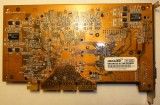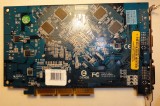I was cleaning out my spare computer parts yesterday and realized that I had saved every video card I’d ever owned. So I thought I’d take some pictures before I chucked them and present a history of video cards.
Diamond Viper II (2000 – 2001)
My first video card ever, I bought this primarily for playing Team Fortress Classic (a Half-Life multiplayer mod) and Unreal Tournament. And at those two games, it did quite well. According to Wikipedia, the Viper II had a mere 12 million transistors and a core clock of 125Mhz. I was surprised to see that it came with composite and S-Video connectors for outputting to TV. You’ll also notice its lack of a fan.
- Diamond Viper II Front
- Diamond Viper II Back
Geforce 2 Ultra (2001 – 2004)
The Geforce 2 Ultra was twice as powerful as the Viper II at a transistor count of 25 million and a core clock of 250Mhz. This card helped me battle my way through classic games of the time such as Jedi Knight 2, Dungeon Siege, Deus Ex, Grand Theft Auto 3, and Rise of Nations. This was the only time I bought a high-end version of a video card.
- Geforce 2 Ultra Front
- Geforce 2 Ultra Back
Later in this card’s life, I put it into a rig I built for my sister, and she of course mistreated it. Hence the fan on the video card seized up and fell off.
Radeon 9600XT (2004 – 2009)
Weighing in at 76 million transistors and a core clock of 500Mhz, the Radeon 9600XT was an excellent video card that held its own right up until 2008 when Shader Model 3 games started coming out. During its reign, I was enjoying games such as Half-Life 2, UT 2004, Company of Heroes, TES4: Oblivion, Counter-Strike: Source, and Dungeon Siege 2. Starting with this video card, I also began using dual-monitors and haven’t looked back since. I modded my card to add copper heatsinks on the RAM chips and later on replaced the HSF with an all-copper one.
- Radeon 9600XT Front
- Radeon 9600XT Back
Geforce 7300GT (2009)
This video card was really only a stopgap until I could build a whole new system. At 177 million transistors and 350Mhz, the 7300GT was one of the last video cards to still support AGP.
- Geforce 7300GT Front
- Geforce 7300GT Back














